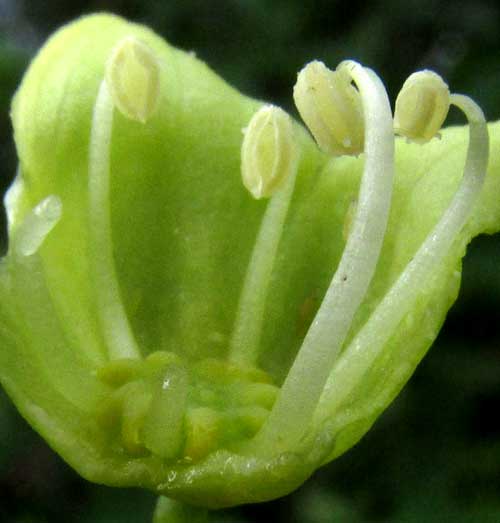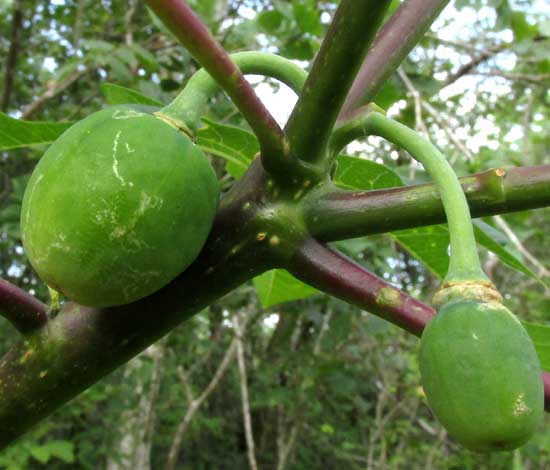Excerpts from Jim Conrad's
Naturalist Newsletter
from the July 31, 2016 Newsletter issued from Hacienda Chichen Resort beside Chichén Itzá Ruins; limestone bedrock; elevation ~39m (~128ft), N20.675°, W88.569°; central Yucatán state, MÉXICO
WILD MANIOC
Along a trail through the woods an eight-ft-tall (2.5m), much branching, woody shrub bore ¾-inch wide (2cm), yellowish-green flowers among deeply palmately lobed leaf blades on long, pinkish petioles. The bush looked a lot like cultivated Manioc, also called Cassava or Tapioca. Below, you can see a flowering branch:

The flowers were handsome ones, bearing no corollas but with their calyxes expanded and colored to attract pollinators, as if they were corollas, and each blossom bore ten stamens, which extended from the flower's mouth at two different levels, as shown below:

With no female parts apparent, a flower was broken open to see if stigma, style and ovary might lie hidden deep within the calyx's bowl, but there was nothing there but glands among the stamens' bases, as seen below:

These were male flowers and I couldn't find female ones. However, the same plant had produced female flowers earlier, because immature fruits were forming on the upper branches, shown below:

Everything here reminded me of the Manioc, a member of the Euphorbia Family, which often produces milky latex from injured parts, so I tore a leaf, and below you can see the resulting white juice:

It was a Manioc, but not quite the cultivated Manioc, Manihot esculenta, which is grown in the tropics worldwide because of its thick, fleshy storage roots that produce a starchy food like boiled potatoes when cooked. Cultivated Manioc isn't as woody as our trail-side bush, and its shoots grow more from the base than our plant's, as you can see on our Manioc Page at www.backyardnature.net/yucatan/manioc.htm
Once I got connected with the Internet, all became clear: In the Yucatan Peninsula we have three wild-growing species of manioc -- species of the genus Manihot. The one in our photographs is MANIHOT AESCULIFOLIA, native from Mexico to Panama.
I read that Manihot aesculifolia can reach 4m in height (13ft).
Last year near Yaxunah 20 kms south of here we met a Manihot at least 4.5m tall (15ft), and I'm guessing that that non-flowering tree was Manihot carthaginensis, which you can see at www.backyardnature.net/mexnat/manihot1.htm